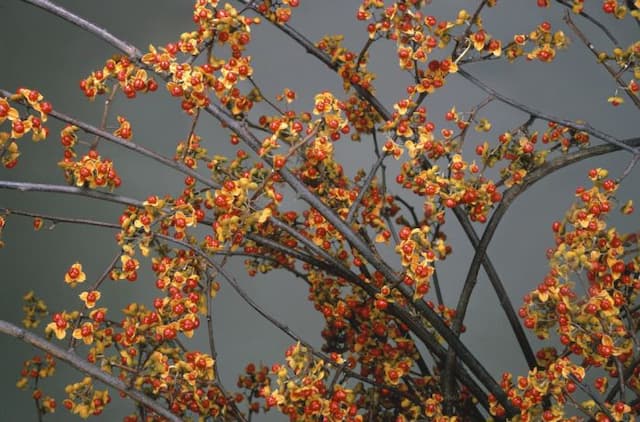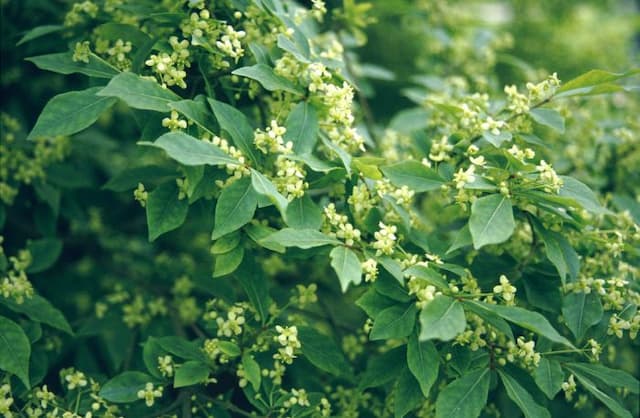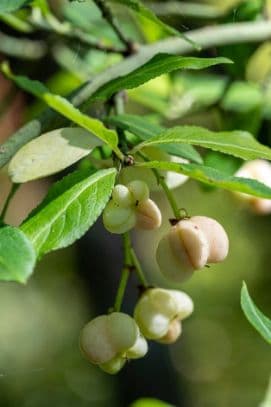Spindle Tree Euonymus hamiltonianus 'Indian Summer'

ABOUT
The Indian Summer spindle tree is a visually appealing plant with several distinctive features. Its leaves have a broad ovate shape with finely serrated edges and come in a rich green color during the growing season. As autumn approaches, these leaves undergo a remarkable transformation, turning into vibrant shades of orange, red, and purple, providing a striking display of fall color. The bark of this plant is also worth mentioning, as it is smooth with a light to medium gray tone that provides a pleasant contrast against the foliage. Moreover, in late spring to early summer, the Indian Summer spindle tree produces a profusion of flowers. These blooms are somewhat inconspicuous, often small and yellowish-green in color, and grow in clusters. Following flowering, the plant bears fruit which are a highlight in themselves. The fruits are capsules that, upon ripening, split open to reveal bright orange seeds, adding yet another layer of interest to the plant's appearance. This burst of seed color emerges even as the leaves change, lending a dual-tone aesthetic to the specimen during the cooler months. All in all, the Indian Summer spindle tree is known for its seasonal transformations which are visually striking, providing year-round visual interest with its changing leaf colors, textured bark, and uniquely colored fruits.
About this plant
 Names
NamesFamily
Celastraceae
Synonyms
Spindle Tree, Hamilton's Spindle Tree, Indian Summer Euonymus
Common names
Euonymus yedoensis var. montana, Euonymus bungeanus, Euonymus yedoensis, Euonymus sachalinensis, Euonymus maackii.
 Toxicity
ToxicityTo humans
Spindle tree contains various toxic compounds that are harmful if ingested. All parts of the plant are toxic, including leaves and seeds, which contain cardiac glycosides and alkaloids such as evonoside and euonymin. If any parts of the plant are ingested, symptoms of poisoning may include nausea, vomiting, diarrhea, weakness, chills, convulsions, and liver failure. In severe cases, ingestion can lead to cardiac complications or death. It's crucial to consult a medical professional promptly if ingestion is suspected.
To pets
Spindle tree is also toxic to pets. It contains compounds like cardiac glycosides and alkaloids that can cause poisoning if any part of the plant is ingested. Common symptoms in pets may include vomiting, diarrhea, abdominal pain, weakness, and heart rate abnormalities. In severe cases, ingestion can cause seizures, liver failure, or even death. If you suspect your pet has ingested any part of this plant, seek immediate veterinary assistance.
 Characteristics
CharacteristicsLife cycle
Perennials
Foliage type
Deciduous
Color of leaves
Green
Flower color
Greenish-white
Height
15-20 feet (4.6-6 m)
Spread
15-20 feet (4.6-6 m)
Plant type
Shrub
Hardiness zones
5
Native area
Asia
Benefits
 General Benefits
General Benefits- Ornamental value: With its striking autumn coloration and attractive fruits, it provides a pleasing aesthetic to gardens and landscapes.
- Wildlife attraction: The fruits of the plant attract birds and other wildlife, offering them a source of food.
- Low maintenance: Once established, the Spindle tree is easy to care for, requiring minimal upkeep.
- Drought tolerance: It is relatively resistant to drought, making it suitable for gardens in areas with lower rainfall.
- Versatility: Suitable for hedging, standalone specimens, or part of a mixed border, offering great flexibility in garden design.
- Hardiness: The plant is able to withstand cold temperatures, making it suitable for cultivation in many temperate regions.
- Seasonal interest: Provides visual interest throughout the seasons, from spring flowers to autumn leaves and fruits.
 Medical Properties
Medical Properties- This plant is not used for medical purposes.
 Air-purifying Qualities
Air-purifying QualitiesThis plant is not specifically known for air purifying qualities.
 Other Uses
Other Uses- Wildlife Attraction: Euonymus hamiltonianus 'Indian Summer' can provide food for birds, especially in the winter when its fruit becomes a valuable resource.
- Natural Dyes: The fruits and bark of the plant can be used to create natural dyes for fabrics and yarn, offering a range of colors from pink to light brown.
- Privacy Screening: The dense growth habit of the plant makes it effective for privacy screening in gardens or along property borders.
- Hedge Plant: Its robust nature allows it to be pruned into formal hedges or shaped for landscape design.
- Erosion Control: The root system can help stabilize soil on slopes and prevent erosion.
- Architectural Interest: With its striking autumn colors and persistent fruits, it can be used for adding architectural interest to garden designs during the colder months.
- Photography: The striking appearance in fall, when its leaves turn a brilliant red, provides excellent opportunities for nature photography.
- Craft Material: Stems and branches may be used in crafting, for wreaths or as part of dried flower arrangements.
- Bonsai Specimen: The species can be trained as a bonsai, providing year-round interest with its foliage, shape, and berries.
- Folk Art: The berries and leaves can be used as motifs or actual components in folk art creations.
Interesting Facts
 Feng Shui
Feng ShuiSpindle tree is not used in Feng Shui practice.
 Zodiac Sign Compitability
Zodiac Sign CompitabilitySpindle tree is not used in astrology practice.
 Plant Symbolism
Plant Symbolism- Transformation: Euonymus hamiltonianus 'Indian Summer', more commonly known as Spindle tree, often symbolizes change and transformation because it undergoes a dramatic change in color throughout the seasons.
- Protection: The Spindle tree has been traditionally thought to offer protection, possibly due to the hardness of its wood which was used to make spindles for spinning wool.
- Endurance: This tree is known for its ability to endure different climates and soils, symbolizing resilience and adaptability in the face of challenging conditions.
 Water
WaterSpindle tree 'Indian Summer' prefers consistent moisture, but it is important to avoid overwatering. Water the plant when the top inch of soil feels dry to the touch. Typically, this will mean watering once every week during active growth in spring and summer, but frequency should be adjusted depending on weather conditions and soil drainage. During the winter dormant period, reduce watering frequency to every two to three weeks. Aim to provide about 1 gallon of water at each watering for a medium-sized shrub, ensuring that the water penetrates deeply to encourage strong root development.
 Light
LightSpindle tree 'Indian Summer' thrives best in full sun to partial shade. This plant will perform well when it receives at least 4 to 6 hours of direct sunlight each day. A spot that offers morning sunlight and some afternoon shade is ideal, especially in regions with extremely hot summers.
 Temperature
TemperatureSpindle tree 'Indian Summer' is hardy and can tolerate a wide range of temperatures, but it performs best when conditions are not too extreme. The plant can survive winter temperatures down to around -20°F and can handle summer temperatures up to 95°F. However, the ideal growing temperatures are between 60°F and 80°F.
 Pruning
PruningSpindle tree 'Indian Summer' should be pruned to remove any dead or damaged branches, maintain its shape, and encourage healthy growth. The best time for pruning is in the late winter to early spring before new growth begins. Light pruning can also be done in summer if needed. Typically, pruning once a year is sufficient to keep the tree healthy and well-shaped.
 Cleaning
CleaningAs needed
 Soil
SoilSpindle tree thrives in well-draining, loamy soil with a pH range of 6.0 to 7.5. A mix of garden soil, peat, and perlite or sand can create an ideal growing medium, ensuring good aeration and moisture retention. Adding organic matter like compost can further enrich the soil and provide nutrients for healthy growth.
 Repotting
RepottingRepot the Spindle tree every 2 to 3 years to replenish its soil and encourage growth. Younger plants may require more frequent repotting, while mature specimens can be repotted less often, only when they become root-bound.
 Humidity & Misting
Humidity & MistingSpindle tree is adaptable to a range of humidity levels but prefers moderate humidity. It can tolerate some dry air but maintaining a humidity level around 40-60% is ideal for this plant's health and vigor.
 Suitable locations
Suitable locationsIndoor
Bright, indirect light and room to grow.
Outdoor
Full sun to partial shade, shelter from winds.
Hardiness zone
4-7 USDA
 Life cycle
Life cycleEuonymus hamiltonianus 'Indian Summer', commonly known as Spindle tree, begins its life cycle when seeds germinate in the spring, after a period of cold stratification that breaks the seed's dormancy. The seedlings grow into juvenile plants, developing a root system and foliage, and over the next few years, they mature into adult plants with a woody stem structure. As adult plants, they go through annual cycles of flowering and fruiting; the small, insignificant flowers bloom in late spring to early summer, followed by the development of pink to red fruits by fall, which open to reveal attractive orange seeds. These seeds are then dispersed by birds, wind, or gravity and mark the beginning of a new generation. During winter, the plant experiences dormancy, with leaf fall occurring in colder climates, but the tree's woody structure allows it to withstand the cold until growth resumes in spring. The Spindle tree can live for many years, continuously going through these growth stages during its lifetime, with environmental factors and pruning influencing its growth habits and longevity.
 Propogation
PropogationPropogation time
Summer
Euonymus hamiltonianus 'Indian Summer', commonly known as the Indian Summer Spindle Tree, is typically propagated by seed or softwood cuttings. However, the most popular method for propagating this plant is through the use of softwood cuttings, which are taken in late spring or early summer. To propagate by cuttings, you should select healthy, non-flowering shoots and cut sections of about 4 to 6 inches (10-15 cm). These cuttings are then treated with a rooting hormone to encourage root development and planted in a well-draining soil mixture. The pots with cuttings should be kept in a warm area with indirect sunlight and high humidity, often facilitated by covering the pots with a plastic bag or placing them in a greenhouse. After the cuttings have rooted, which usually takes a few weeks, they can be transferred to individual pots and grown on until they are ready to be planted out.




![Spindle [Blondy]](/_next/image?url=https%3A%2F%2Fplants-admin.emdemapps.com%2Fimages%2Fplants%2F%2Fimages%2F604b642f54add.png&w=640&q=75)



